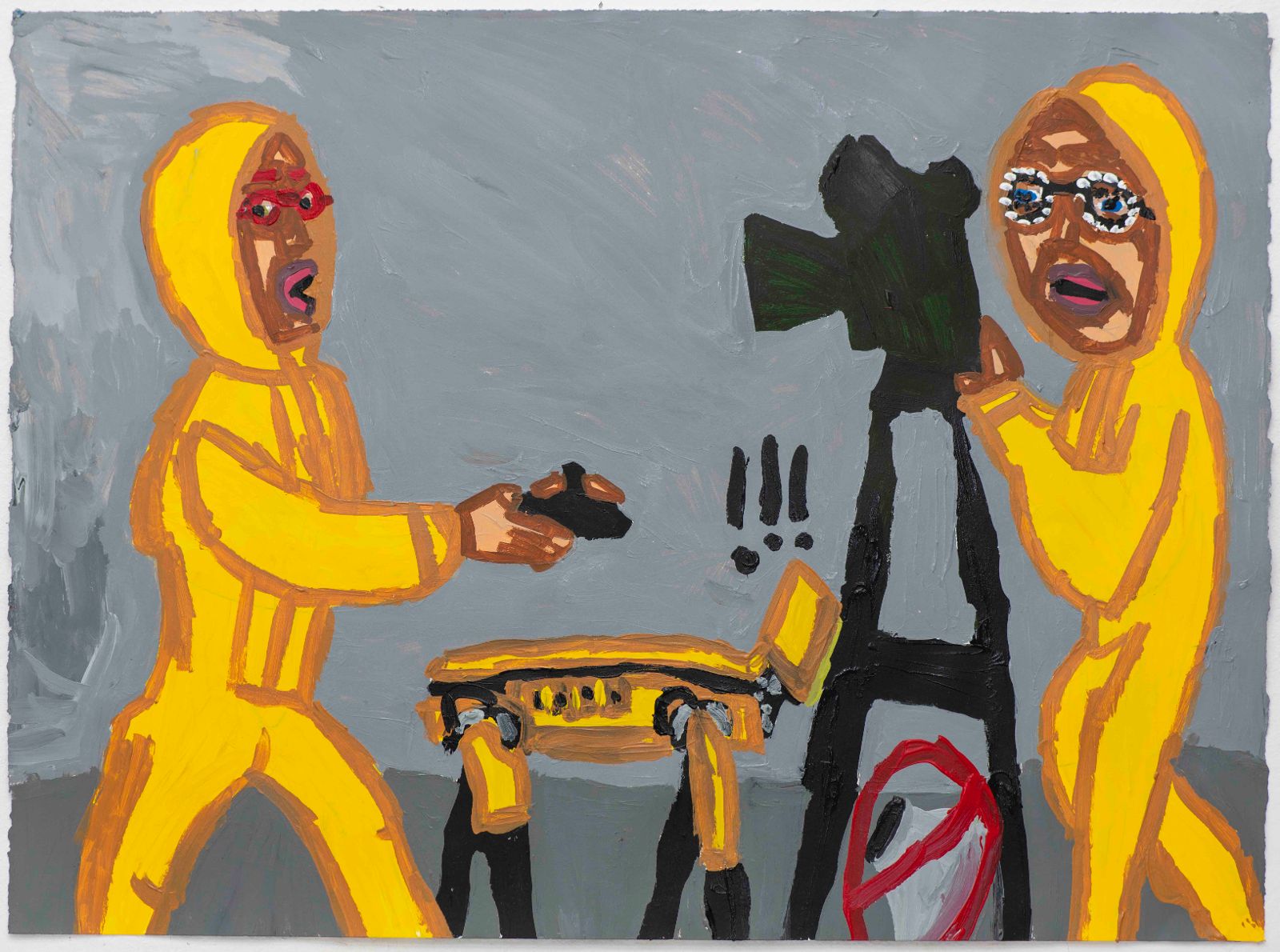
Recently, the perceived threat of artificial intelligence (AI) has accelerated in our latent consciousness. There are concerns about social biases, the locus of technological control and the doubtful intentions of unregulated technocrats and their digital mega economies. The impact of AI in the arts has generally been discussed in terms of authorship, challenges to intellectual property and authenticity against an "original" creative source. Even the premise of creativity itself has been under question.
Exhibited last autumn at Gertrude Glasshouse, Dog Robot Space Star speculated on such infinite possibilities, with artists Catherine Bell and Cathy Staughton—working collaboratively as the Two Cathies—bringing the hyper stimuli of AI to an everyday tragi-comic human domain.
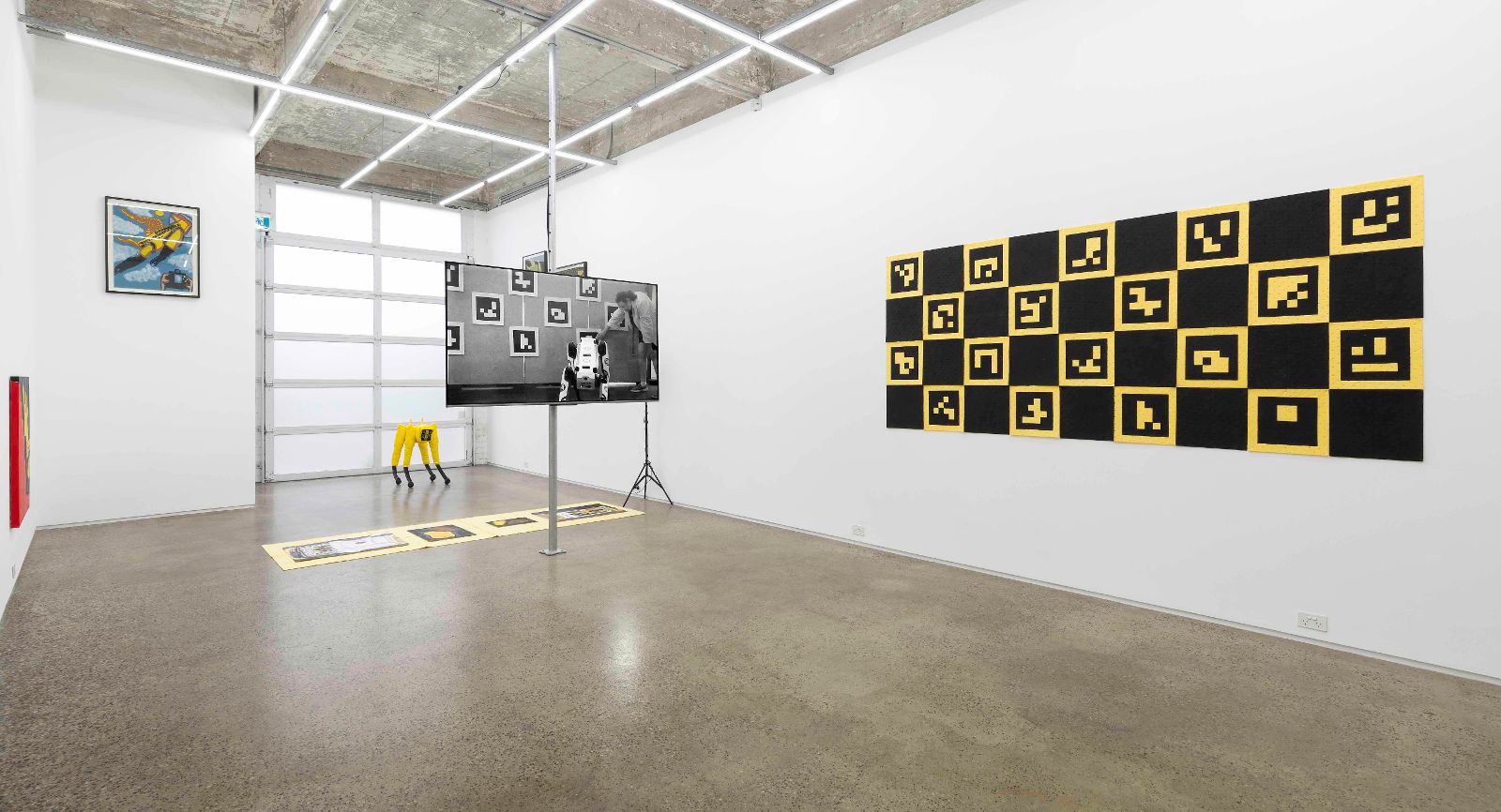
Since first meeting at Arts Project Australia (APA) in 2009, the duo have worked together, forming an enduring artistic partnership.[1] Over fifteen years, they have established a unique bond shaped by a shared visual language, social media, painting, filmmaking, a love of dogs, grief, loss and empathy.
As individual artists, they each bring a distinct set of interests. Catherine Bell’s academic research is underpinned by socially engaged projects focused on feminism, the ethics of care, disability and mortality. The sensitivities and realities of death are present in her practice.[2] In challenging our ‘inherent reticence around the topic',[3] she constructs memento mori from funerary materials, articulating the liminal space between life and death.
Cathy Staughton, a neurodivergent/deaf artist, works in the supported studio at APA. Communicating primarily via visual language, Cathy’s lingua franca is tech-propelled image sharing–she fluently, and nimbly, juggles iPhone texting, iPad googling, signing and gesture. Cathy also reflects her lived experiences in detailed and vibrant paintings; the immediacy of her life is directly relayed onto canvas and paper in a constant flow of expression.
In 2022, Catherine was approached by Brad Crammond, Research Lead at the RMIT Health Transformation Lab in Melbourne, about implementing art projects in healthcare settings. The Lab, self-described as "anti-disciplinary", works across design, technology and cybernetics, approaching its research through human centred design, anthropology and phenomenological methods, among others.[4] It is also home to the Boston Dynamics robot dog Spot–an immediate appeal for the Two Cathies.
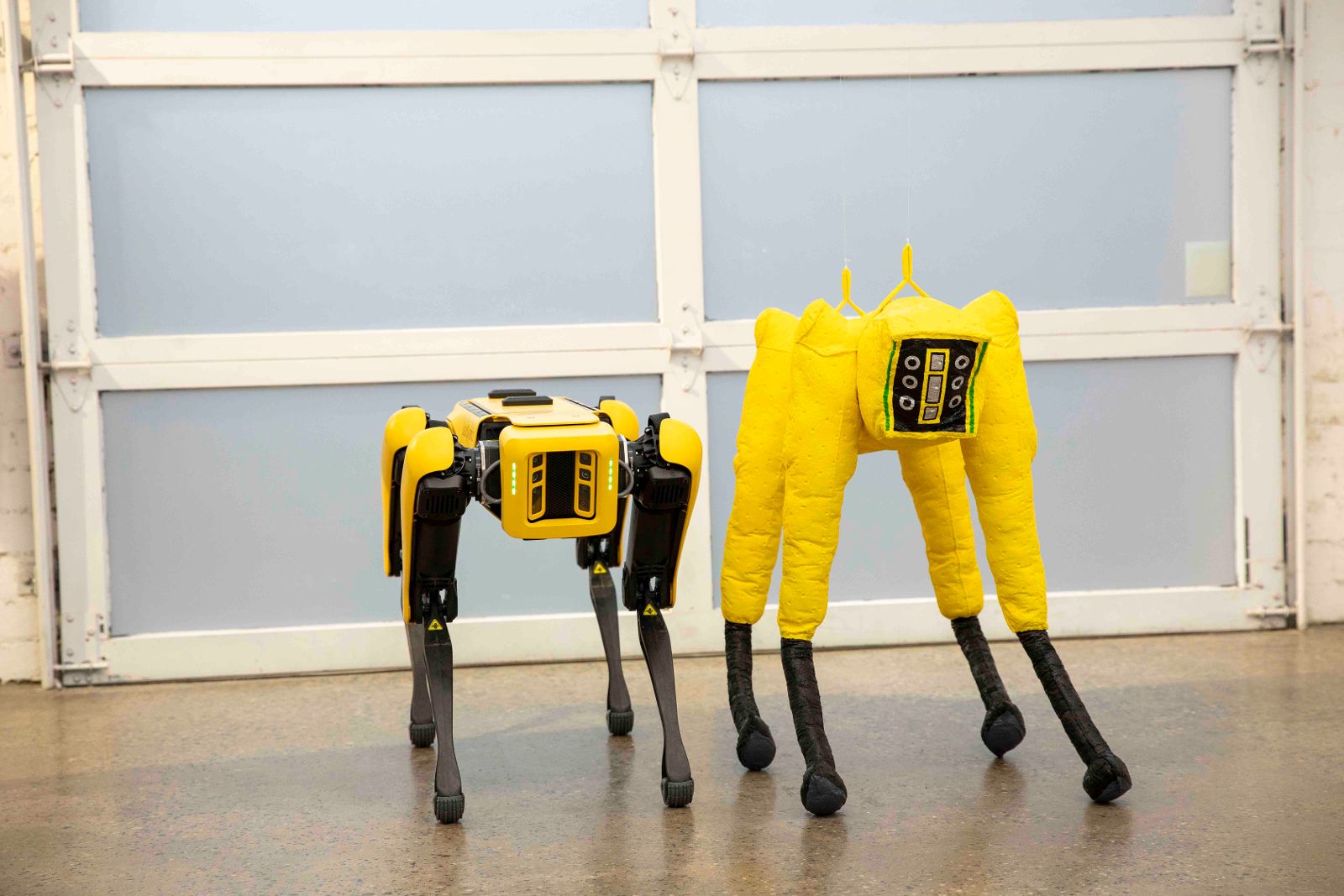
Over six to eight months, the multi-dimensional project Dog Robot Space Star was created in residence and in-situ at the Lab. The final exhibition featured an installation of vivid paintings by Cathy, and a moving image work written, filmed and directed by Catherine. Reminiscent of black-and-white silent movies, the film Dog Robot Space Star (2022) is a sweet slapstick sci-fi story starring Cathy as a scientist/carer nurturing a lab-created robot dog. Elements of light, movement, the robot’s point of view and hints of dada-ism are incorporated into the work to form a strange non-linear story ending with a trip to the stars for Spot.
During the creation phase of a Two Cathies production, project management lies solely with Catherine, who undertakes extensive planning: seeking funding, managing relationships with Cathy’s family, the APA studio and support workers; handling technical equipment and the provision of art materials, as well as scheduling precise daily routines. To ensure Cathy’s whole-hearted engagement in their collaborations, an exacting degree of care is required. It is considerable and complex: this level of care liberates and energises Cathy, ensuring her agency is amplified and her contributions more easily expressed.
While immersed in the collaborative process, the two artists riff off one another in a shared language built upon Cathy’s neurodiverse perspective and unique vernacular. The conversations can be fast and furious, swinging between images, sign language and text messaging. A symbiosis develops, each stimulated by the other’s activity. Cathy rocketing around in her world of images–trawling the internet among a plethora of pics, notations and signs–generates Catherine’s response, similarly abundant with ideas for the film’s narrative and direction. The two bodies of work are created simultaneously. Cathy’s paintings include images from the filmmaking process and vice versa, and both come together to form an integrated installation.
Conceptually, the works of Dog Robot Space Star tackle a duality of care, within the disability space and the human interface with artificial intelligence. Current discourse is clear: people are worried AI may eclipse humanity and take our agency, whereas ironically, disabled people are still advocating to have control over their own lives. In the film, the role of the assistant robot, a technology typically tasked with managing a disabled person’s support needs, is amusingly reversed, with Cathy’s character caring for the robot like a real-life treasured pet—including toileting problems. The inversion of roles is particularly poignant in the disability politic of dependency and the ethics of true care.
Both artists bring an unflinching human perspective to their hi-tech subject. Cathy’s love of popular culture robot icons, such as R2D2, makes an easy leap to working with Spot ‘dog robot’, despite its zoomorphics being limited to just four legs. The usual soft brown eyes and pricked up ears, or appealing features of a canine face, are reduced to a flat digital display panel. Spot can be perceived as forbidding and sinister, particularly as a technology with the potential to be weaponised for police and military operations. Cathy’s familiarity and affection for Spot, however, blurs the line between IRL doggie-ness and the cold tech mechanics of the industrial yellow quadruped.
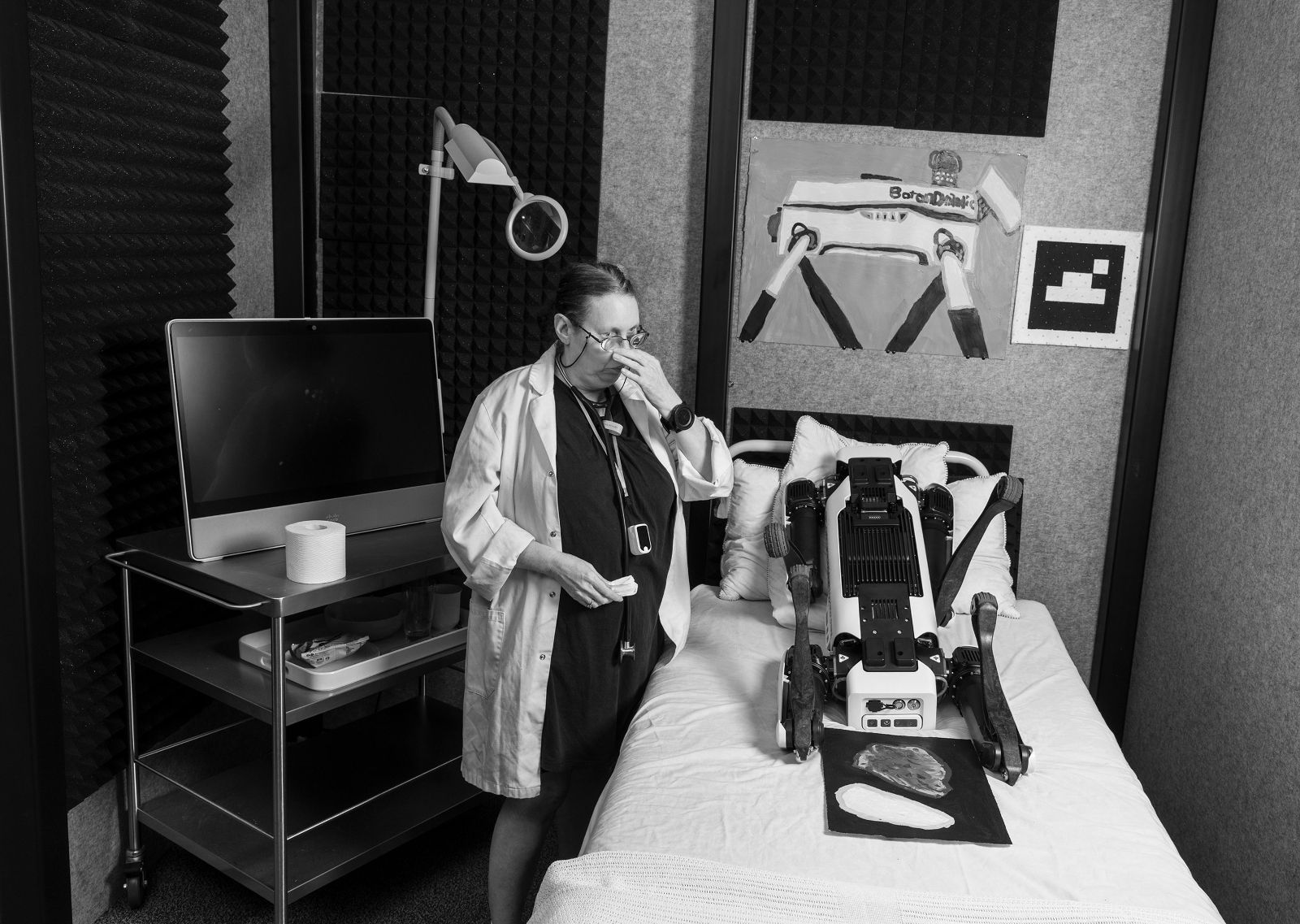
The spectre of death threads its way into the film’s narrative when Catherine’s little dog, Archie, was diagnosed with terminal cancer. Images and ideas associated with death and dogs, angels, clouds, stars and space circulated between the two artists as they worked, and subsequently appear in the film. In reality, death was also stalking Catherine far more distressingly. In May 2023, she experienced the sudden death of her brother, David. A grieving, distraught Catherine had to contend with completing the project under these circumstances, and Cathy provided her with close comfort, texting images and words, ‘Memory Good Heaven Journey Forever Sky Space Angel David Bell Dream…’
Responsiveness, empathy and compassion are human feelings that may not be the domain of artificial intelligence. How artists might interpret AI as a rapidly evolving technology into projects that enrich our cultural lives is yet to be seen. The current “gee whiz” factor of AI may mislead practitioners towards simplistic outcomes. For example, Spot the robot dog will reappear as a contemporary art star in the National Gallery of Victoria's 2023 Triennial, (ironically, launching 3 December, the International Day of Persons with Disabilities), performing the “trick” of painting. As a contribution to current discourse on AI, the curatorial decision to include this glamorously promotional project in the Triennial[5] is not particularly edifying. The works presented by the Polish artist Agnieszka Pilat have Spot painting with its “feet”, the artist claiming to have created ‘a hybrid idiom that relates the grandeur of oil on canvas to the radicalism of machine vision’.[6] Why not something more existential?
Ai-Da,(b.2019–) the world’s first ultra-realistic robot artist, who can draw, paint and sculpt, is a performance artist who engages in debates on art. As a machine-embodied AI, her artist persona is the artwork. The United Nations-hosted AI For Good Global Summit states, ‘If Ai-Da does just one important thing, it would be to get us considering the blurring of human/machine relations, and encouraging us to think more carefully and slowly about the choices we make for our future.’[7]
Dog Robot Space Star, light-hearted at first take, reflects on the interfaces at the heart of the philosophical, technological and sociological debates surrounding AI. The exhibition asserts the need to keep these dialogues relevant to the community and our deeply human concerns. In Cathy’s words, 'Dog Robot Space Angel God Death Heaven Brightful Delightful Grateful'.
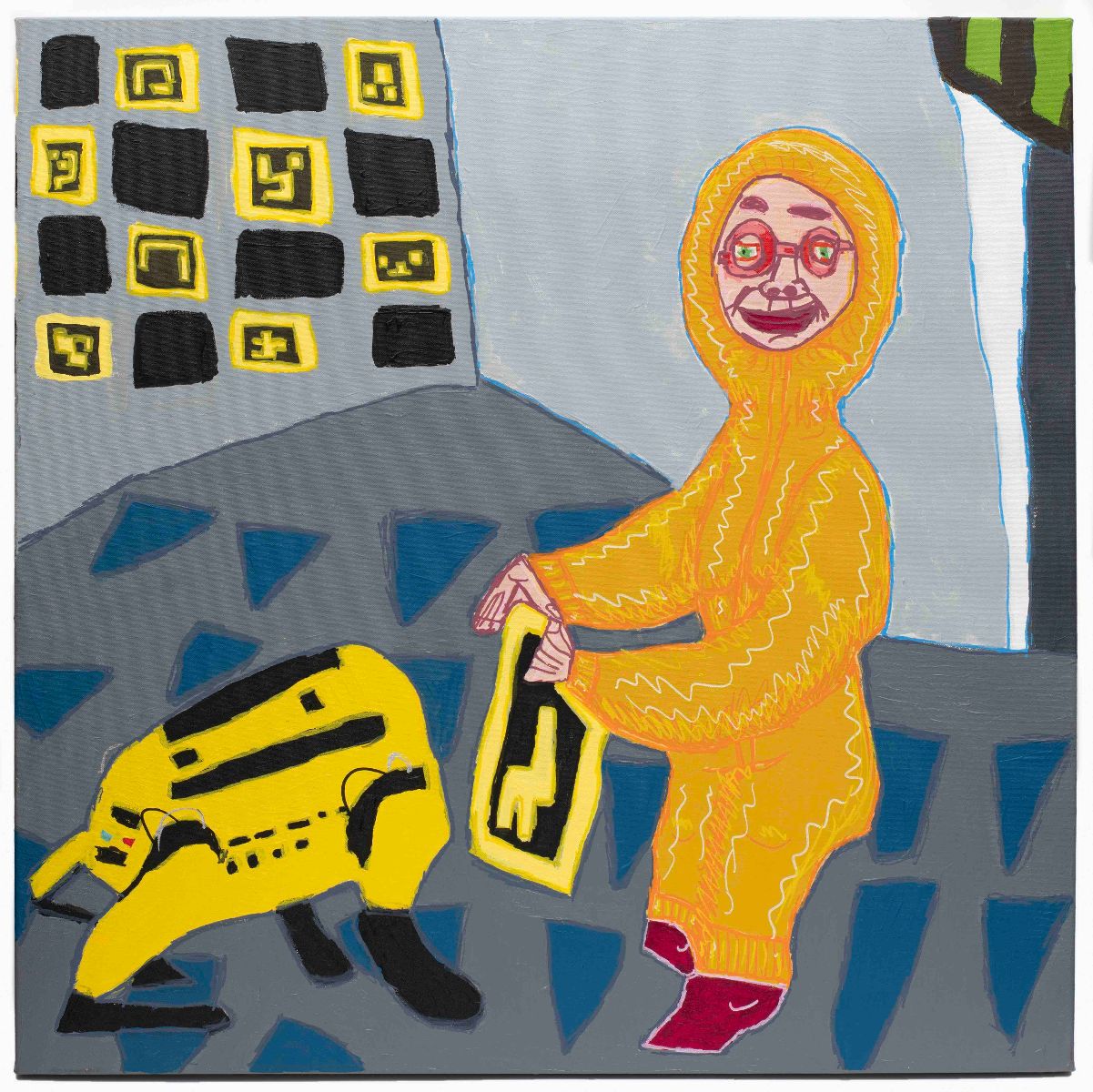
Footnotes
- ^ Arts Project Australia works with neurodiverse artists through a supported studio and gallery, promoting and advocating for their inclusion in contemporary art practice.
- ^ A key example is the exhibition Death Becomes Her, presented at Sutton Gallery, Naarm / Melbourne, 5 March – 2 April 2022.
- ^ Catherine Bell in We Die As We Live, Monique Silk, exh. cat., (Naarm / Melbourne: St Vincent’s Hospital, 2017), 6.
- ^ RMIT Health Transformation Lab website, accessed 21 Nov 2023.
- ^ Matthew Westwood, “It’s puppy love when robot dogs are art’s best friend”, The Australian, 5 April 2023; Stephen A. Russell, “Robot dogs are coming to Melbourne to make art, not war”, The Age, 5 April 2023.
- ^ Agnieszka Pilat, artist website, accessed 21 Nov 2023.
- ^ AI for Good: Global Summit 24, “Ai-Da Robot”, accessed 21 Nov 2023.
